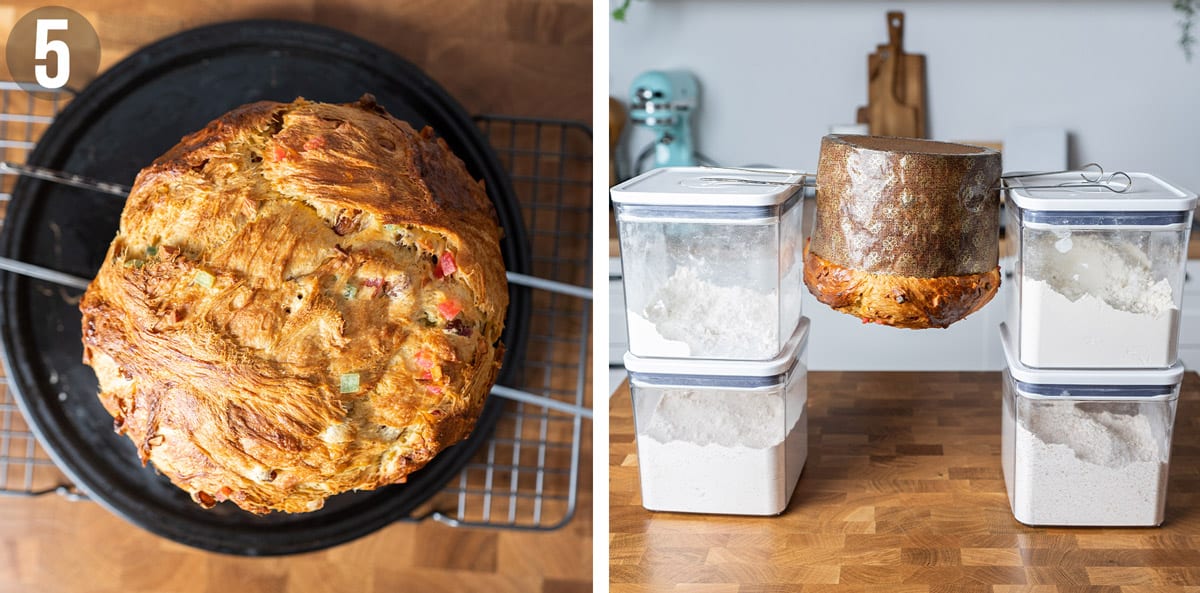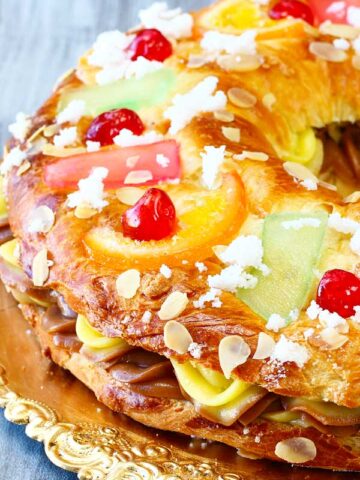A success-guaranteed panettone bread recipe that I've been making for years without fail. Imagine a tall, buttery, and fluffy brioche with candied fruits and almonds, with amazing citrusy smell. It's perfect for Christmas and the holidays!

📮 Save this recipe for later!
Jump to:
- What Is Panettone?
- Why This Recipe Works
- Ingredients For This Recipe
- Timeline For This Recipe
- Step-By-Step Instructions
- Recipe Expert Tips For Making Perfect Panettone
- How To Prevent Panettone From Collapsing
- How To Serve, Store, And Freeze
- Recipe FAQs
- More Holidays Recipes
- Watch How To Make It
- 📖 Recipe
- 💬 Comments
What Is Panettone?
This sweet bread is originally from Italy and is usually made for Christmas or New Year in countries like the USA, Australia, and Canada. It's also widely common throughout Europe.
The word panettone came from the Italian "panetto", which means a small loaf of bread. Since it's nothing of small size, the word was adjusted by adding "one" at the end of it, which accurately means a large bread. Some even refer to it as panettone cake.
Panettone bread is known for its tall-domed shape and its light, buttery, and fluffy texture. The process involves proofing the dough 3 times to achieve its signature characteristics. Over the years there've been varieties of shapes and flavors of panettone but the classic one like what I'm showing you today remains the favorite.
Why This Recipe Works
I've been making this homemade panettone recipe for more than 10 years. I make it every year for Christmas and everybody loves it. Here's why this is the best panettone recipe ever (heavily biased, I know)!
Easier than it looks - Don't be intimidated to make panettone bread at home. It's not as difficult as you think. I've put together all the tips and tricks that I've gathered all these years so that you don't get overwhelmed. Enjoy the process, it's so satisfying, fun, and rewarding at the end!
Soft and fluffy panettone - You'll get a tall, soft, and fluffy panettone bread that's rich, buttery, and with the perfect sweetness. There's nothing better!
Success-guaranteed recipe - I want you to be able to make this panettone bread recipe and enjoy it with your loved ones. That's why I've written in detail all the tips and tricks that I've been developing over the years so that you can make this panettone bread recipe successfully on the first try.
If I still can't convince you to give this easy panettone recipe a try, perhaps you'd want to make a mini-sized panettone? My mini chocolate panettone is so delicious and easier to make.
I have more recipes for the holidays like Marco's family easy fruitcake, mini yule log cakes, and also this irresistible nuts-free snowball cookies!
Ingredients For This Recipe

Bread flour - With 12g-13g protein/100g. A must in this panettone bread recipe. It's also known as high-protein flour. It's the key to developing gluten so you'll get soft, fluffy, good-structured panettone bread.
Citrus - I love the combo of orange and lemon zest. Even the raw dough smells amazing. My whole orange blender cake and olive orange cake are for you if you love oranges. Clementine works also for this panettone bread recipe.
White sugar - I choose good old granulated white sugar for this panettone bread recipe so that it doesn't affect the panettone bread's color if I were to use brown sugar, for example.
Candied fruits and raisins - Dried candied fruits, not the ones in jars that come in syrup. I use orange peel, cherries, and plums. You can also swap these for variations of nuts like almonds, pecans, walnuts, etc.
Orange juice - To soak the raisins and also infuse the dough.
Almonds - Any nuts will do, preferably toasted for better flavor. They give a nice contrast texture.
Yeast - I love instant dry yeast in this panettone bread recipe because it's easier to use, just add it together with other ingredients without having to activate it with water first, just like I use it in my amazing Lebanese flatbreads (Man'oushe za'atar). Use 4 ½ teaspoon (14g) of active dry yeast or 36g of fresh yeast. For both active dry yeast and fresh yeast, activate them with the warm milk before adding the mixture with the other ingredients.
⭐ See the recipe card for full information on ingredients and quantities.
Timeline For This Recipe
I'm sharing with you how to make panettone at home as I've been doing it all these years. I highly recommend you follow these so you can make it successfully with no hassles.
- Plan ahead - A panettone bread recipe involves hours but with lots of waiting time. This panettone bread recipe comes with 3 proofs (dough risings). I'd recommend you clear 1 whole day when you're actually making it.
- Day 1: Prep - Read this panettone bread recipe carefully. The night before weigh all the ingredients, soak the raisins, and chop the candied fruits and nuts. Prepare the utensils needed like the mold, a baking tray to put the mold on, a sharp knife, 2 metal skewers to stick into the panettone, and a pastry brush. Think of where you're going to flip and hang the baked panettone. I use 4 stacked flour containers. I like to do this to make sure I have everything I need and I know where they are. Zero stress!
- Day 2: Make and bake - I start early in the morning. You don't want to start late and finish at night. The first thing I do is to take out the sliced butter from the fridge and place it in a warm ambiance like in the kitchen while we prepare and have breakfast. Then I start with the panettone recipe. Usually this day we'll have a very simple lunch like noodle soup where I don't need to cook so much.
Step-By-Step Instructions
1. First proof - Add all of the ingredients for the first proof in a standing mixer bowl. Take ¼ cup of the orange juice from soaking the raisins and add it in. Mix well and then knead for 10 minutes. Cover the bowl tightly with cling film and leave until the dough rises to double its size. This could take around 1-2 hours.

2. Second proof - Punch the dough to let the air out. Add egg yolks, sugar, and vanilla extract and mix well. While mixing, add the cubed butter bit by bit until they're all incorporated. This process could take more or less 5-10 minutes. Then knead until the dough forms a ball. This will take around 20-30 minutes. Have faith, it will form a ball. Cover the dough tightly with cling film and leave until the dough rises to double its size. This could take around 1.5-2.5 hours.

3. Third proof - Grease your working surface and your hands with some oil or butter. Pour the dough on it and stretch it into more or less a square shape. Sprinkle candied fruits and almonds on top. Squeeze the raisins to discard the orange juice and sprinkle them on the dough. Gently knead the dough to distribute them evenly. Fold it into an envelope, flip and place it inside the panettone mold, on a baking tray. Cover loosely with cling film until the top dome reaches almost 1 inch to the brim of the mold. This could take 40-80 minutes.

4. Bake - Gently brush the top with some egg wash. Using a sharp knife, make a shallow cross on top. Place some slices of butter in the cross. Bake in a preheated oven at 360ºF (180ºC) for 60-70 minutes, or until a skewer inserted comes out clean. Cover the panettone bread loosely with aluminum foil if the top browns too fast.

5. Flip - Once removed from the oven, immediately poke 2 metal skewers through the panettone. Gently flip it upside down and leave it to cool completely for 3-4 hours before slicing. Enjoy your panettone bread!

Recipe Expert Tips For Making Perfect Panettone

- Correct measurement - I'm a strong believer in kitchen scale. It's the only accurate way to weigh dry ingredients. In this panettone bread recipe, we don't want extra flour which usually happens when you use cup (volume) measurements. However, I do write all my recipes in both measurements, for you to choose from. Use the spoon and level method, if you're using cup measurement for this panettone bread recipe.
- Warm ambiance - If you're making this panettone bread recipe in the summer, then perfect! But if you're making this in the cold weather, then the dough will take longer to rise. Yeast needs a cozy warm ambiance to do its thing.
What I usually do is heat my oven at 75ºF (23ºC) for 2-3 minutes and then turn it off. I let the dough rise inside the oven (bowl tightly covered, placed on a wooden board). Now and then I check, and if it feels cold I heat up my oven again. I find this very helpful to create a steady continuous warm ambiance for the dough to rise beautifully. - Standing mixer - People back then made panettone bread using their own bare hands. I'd really recommend you use a standing mixer to make it easier. It's going to save time and energy (haha!). Also, the dough is very sticky, so using a standing mixer will definitely prevent you from getting panicky and overwhelmed while dealing with the dough.
- No extra flour - This dough is sticky and a bit tricky to manipulate. Do not add extra flour as it'll make the panettone dense. Oil your working surface and your hands to prevent the dough from sticking. Remember, no extra flour in this panettone bread recipe.
- Don't overproof the dough - For the final proof, the dough in the mold should not rise over the brim of the mold. The top dome of the dough should rise just until around 1 inch (2.5cm) before the brim of the mold. If you overproof the dough at this stage, your panettone bread will not rise beautifully in the oven.
- Place the mold containing the dough on a baking tray - This will make it easier to move it around to bake it later, without risking deflating the dough.
How To Prevent Panettone From Collapsing

By hanging the panettone bread upside down while it cools down. I know it might sound silly but it's the most important step of all for this panettone bread recipe. You will prevent the beautiful tall dome from collapsing that'll make the panettone bread dense. Don't throw all your day's effort by skipping this last step.
What I do is insert 2 metal skewers through the panettone bread while it's still hot and carefully hang it upside down on stacks of flour containers. Usually, it takes 3-4 hours for it to cool.
How To Serve, Store, And Freeze
Serve - Best consumed on the day of baking like any other fresh homemade bread. Cut the panettone bread into tall wedges to serve with some sweet drinks, wine, hot tea, coffee, or chocolate!
Store - In an air-tight container, at room temperature. It lasts up to 5 days. The texture will start getting dry as the days pass, that's natural since we don't add any preservatives to this panettone bread recipe. No worries! Reheat it in the microwave for a few seconds and it'll be as if it just came out from the oven!
Freeze - In an air-tight container for up to 3 months. Thaw at room temperature. Remember to reheat it to bring it back to its glory!
Recipe FAQs
Nope. All-purpose flour is low in protein content and will not be able to produce tall, structured, fluffy panettone.
This is a classic panettone bread recipe that I've been making for years without changing it. Whole-wheat flours tend to absorb more liquid so adjustments and testings have to be made to the recipe, which I haven't done. So nope, use white bread flour.
Yes! It's important if you want that fluffy texture of bread in this. Since it's such a tall bread, this step also prevents it from collapsing on itself.
Nope. Cutting it while it's still warm will give the impression that the panettone bread is not fully cooked and the texture is dense. Wait until it's totally cold, it's worth it.
1) If the texture is dry on the day that you baked it, then you've overbaked it. Use a portable oven thermometer to get an accurate temperature. When baking, place it on the lowest rack so the growing top doesn't get burnt. 2) If the texture feels dry the days after, then it's natural since we don't add any preservatives to it. Simply reheat it for a few seconds in the microwave and it'll be just as if it just came out from the oven!

More Holidays Recipes
⭐ If you tried this Panettone Bread Recipe or any other recipe on our website, please leave a 🌟 star rating and let us know how it went in the comments below!
Watch How To Make It
📖 Recipe

Panettone Bread Recipe
Equipment
- Panettone mold
Ingredients
Raisins
- ¼ cup (40 g) raisins
- ½ cup (125 ml) orange juice
The first proof
- 4 ¼ cup (550 g) bread flour
- 1 teaspoon granulated sugar
- 1 ½ teaspoon (1.5 teaspoon) salt
- 1 orange, the zest
- 1 lemon, the zest
- 3 large eggs , room temperature
- ½ cup (125 ml) milk , warm
- 3 ½ teaspoon (11 g) instant dry yeast
The second proof
- ½ cup (100 g) granulated sugar
- 3 large egg yolks , room temperature
- 1 tablespoon vanilla extract
- 7 oz (200 g) unsalted butter , cut into small cubes, softened
The third proof
- 7 oz (200 g) assorted candied fruits , cut into small cubes
- ⅓ cup (50 g) toasted almonds , chopped
Others
- 1 teaspoon oil , to grease the working surface
- 1 egg , for egg wash
Instructions
Raisins
- Soak raisins in orange juice the day before.
The first proof
- Add all ingredients for the first proof in a standing mixer bowl. Take ¼ cup of the orange juice from soaking the raisins and add it in. Mix well and then knead for 10 minutes. Cover the bowl tightly with cling film and leave until the dough rises to double its size. This could take around 1-2 hours.
- Cover the bowl tightly with cling film. Let the dough rise to double its size.
The second proof
- Punch the dough to let the air out. Add egg yolks, sugar, and vanilla extract and mix well. While mixing, add the cubed butter bit by bit until they're all incorporated. This process could take more or less 5-10 minutes, don't rush it.
- Then knead until the dough forms a ball. This will take around 20-30 minutes. The dough will be very soft and sticky at first, but it will form a soft ball at the end. Trust the process. Cover the dough tightly with cling film and leave until the dough rises to double its size. This could take around 1.5-2.5 hours.
- Cover the bowl tightly with cling film and let the dough rise to double its size.
The third proof
- Grease your working surface and your hands with some oil or butter. Pour the dough on it and stretch it into more or less a square shape.
- Sprinkle candied fruits and almonds on top. Squeeze the raisins to discard the orange juice and sprinkle them on the dough. Gently knead the dough to distribute them evenly.
- Fold it into an envelope, flip it, and place it inside the panettone mold of 2 lb (1 kg), on a tray. The tray will make it easier to move the mold without risking deflating the dough.
- Cover it loosely with a cling film and let the dough rise until the top dome reaches almost 1 inch from the brim of the mold. Don't over-rise it. This could take 40-80 minutes.
Bake
- Gently brush the top with some egg wash. Using a sharp knife, make a shallow cross on top and place some butter on the cross.
- Bake at 360ºF or 180ºC, in a preheated oven with the fan turned off, on the lowest rack, for 60-70 minutes or until a skewer inserted in the centre comes out clean.
Flip upside down
- Once removed from the oven, immediately insert 2 metal skewers through the panettone. Gently flip it upside down and hang it until it cools completely for 3-4 hours before slicing. Enjoy!
Notes
- I highly recommend using a kitchen scale for this recipe as it's more precise.
- Use a portable oven thermometer to get a precise oven temperature (I use it all the time).
- The dough will be soft and sticky, do not be tempted to add more flour.
- Do not let the dough rise too much in the third proof stage. The over-risen dough will result in the dough overflowing the mold when you bake it.
- Cover the top loosely with aluminum foil if the panettone browns too fast.
- Never slice a panettone (or any bread!) when it's still hot/warm.
Nutrition Facts
The nutrition facts provided are an estimate per serving. Accuracy is not guaranteed.
Originally published on Nov 23, 2017. Updated with improved text and pictures on Nov 28, 2023.





















Joe Vernice says
Love this recipe. Please provide weight instead of volume since you suggest using a kitchen scale.
Bea & Marco says
Hi, Joe! We've rectified it so that the weight measurements are visible when you print the recipe. Thanks for pointing it out to us!
Joe Vernice says
I have been making panettone Christmas bread for a long time. I decided to try your recipe instead of the King Arthur one that I usually use because this one is faster. Well, not only is it faster, but it is more consistent with regard to creating a nice wispy crumb that is characteristic of a good panettone. My only modification is that I add some citrus extract. This is now my “go to” panettone recipe. Thank you!
Bea & Marco says
We're happy to hear that you love the recipe, Joe! We make this panettone every year, and the even faster mini panettone ones, adding candied fruits instead of chocolate chips. The smell of the raw dough only already brings on the festive mood. Thank you so much for your lovely feedback!
Karen Fazakerley says
Made this yesterday, it was fantastic! I've just got a KA mixer so this recipe had great instructions for creating this which really helped me. It was light and fluffy and delicious, I'll definitely make this again.
Bea & Marco says
Yay! That's awesome to hear. We're happy to know that you enjoyed it, thank you so much for your feedback, Karen.
Janelle says
I want to make panettone in the lovely paper molds for the holidays. So many options... What size of paper molds? 15, 19, 24 oz? You're 1x size recipe to what size paper mold, please? I don't want them tiny, but not chain store size, either.
Bea & Marco says
Hi, Janelle! For this recipe we use a casing of 2 lb (32 oz). It's the perfect size for a family, we make it every year! Hope it helps and feel free to read our tips that we collected over the years making it, have fun!
Yvette says
I want to make this panettone for Christmas. Can I use an Angel cake pan? Awaiting your advice. Thank you.
Bea & Marco says
Hi, Yvette! I haven't tried using an Angel cake pan before so I can't say for sure. You could try it, just make sure it's big enough to contain the dough, and perhaps you'd have to grease the pan generously too. Do refer to the recipe card above for the casing measurement. Hope it helps!
Brülisauer Dalida says
Hello,
I made this recipe last week and really enjoyed the result, nevertheless I feel it could be a bit sweeter. Is it possible to increase the amount the sugar? Thanks
Bea & Marco says
Hi! We're happy to hear that you really liked it. If you prefer it sweeter, yes, add bit more sugar but not too much as it might effect the grow of the dough. Hope it helps!
Natalia says
Unfortunately in my country, they don't sell panettone cases. Can I use a cake tin and parchment paper instead? I am not sure if it can be hung upside down as a homemade case lacks the structure of a shop bought one. Thanks
Bea & Marco says
Hi Natalia, yes you can use a cake tin and parchment paper, and yes you are correct that it probably wont have the strength to be upside down. Maybe you want to try my mini panettone recipe that doesn't require to be hang upside down. You can swap the choc chips for candied fruits. Here's the link to the recipe https://www.elmundoeats.com/mini-chocolate-panettone/